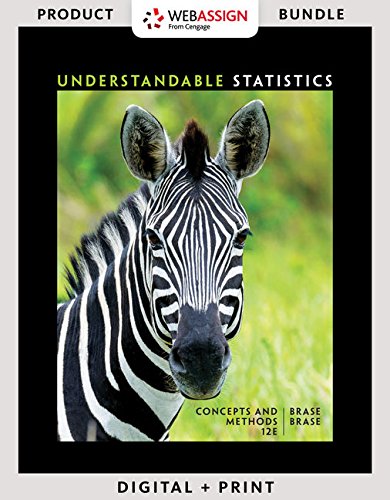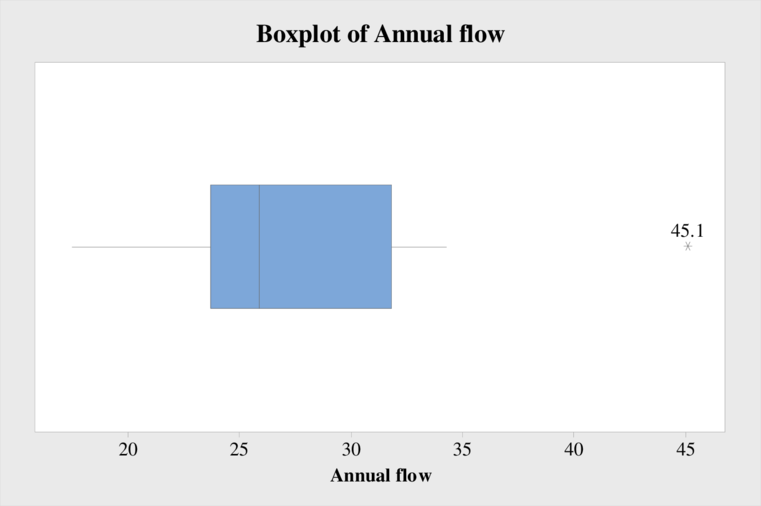
a.
Check whether there is a guaranteed amount of water the farmers, ranchers, and cities will get from the Yellowstone River each year.
a.
Answer to Problem 9CRP
No, there is no guaranteed amount of water the farmers, ranchers, and cities get from the Yellowstone River each year.
Explanation of Solution
The important source of water for wildlife, rancher, farmers, and cities downstream is Yellowstone River. The data show that the annual flow for recent 19 years of the Yellowstone River, which does not show any guarantee that they give water for each year.
The annual flows are random variables. Hence, there is no guaranteed amount of water the farmers, ranchers, and cities will get from the Yellowstone River each year.
b.
Find the expected annual flow from the Yellowstone snowmelt.
Find the
b.
Answer to Problem 9CRP
The expected annual flow from the Yellowstone snowmelt is 27.05.
The value of mean is 27.05.
The value of median is 25.9.
The value of mode is 25.9.
Explanation of Solution
Step-by-step procedure to obtain the mean, median, and mode using the MINITAB software:
- Choose Stat > Basic Statistics > Display
Descriptive Statistics . - In Variables enter the columns Annual flow.
- Check Options, Select Mean, Median and Mode.
- Click OK in all dialogue boxes.
The output obtained using the MINITAB software is given below:

From the MINITAB output, the value of mean is 27.05, the value of median is 25.9, and the value of mode is 25.9.
c.
Find the
c.
Answer to Problem 9CRP
The range is 27.6.
The value of standard deviation is 6.61.
Explanation of Solution
Step-by-step procedure to obtain the range and standard deviation using the MINITAB software:
- Choose Stat > Basic Statistics > Display Descriptive Statistics.
- In Variables enter the columns Annual flow.
- Check Options, Select Mean, Median and Mode.
- Click OK in all dialogue boxes.
The output obtained using the MINITAB software is given below:

From the MINITAB output, the range is 27.6 and the value of standard deviation is 6.61.
d.
Find the 75% Chebyshev interval around the mean.
d.
Answer to Problem 9CRP
The 75% Chebyshev interval around the mean is 13.83 and 40.27.
Explanation of Solution
The 75% Chebyshev interval around the mean is obtained below:
Thus, the 75% Chebyshev interval around the mean for Grid E is 0.77 and 39.93.
e.
Find the five-number summary of the annual water flow.
Draw the box-and-whisker plot.
Interpret the five-number summary and box-and-whisker plot.
Find the values where the middle portion of the data lies.
Find the
Identify the data outliers.
e.
Answer to Problem 9CRP
The five-number summary of the annual water flow is 17.5, 23.7, 25.9, 31.8, and 45.1.
The box-and-whisker plot is shown below:

The middle portion of the data lies between 23.7 and 31.8.
The value of interquartile range is 8.1.
The value 45.1 is an outlier.
Explanation of Solution
Step-by-step procedure to obtain the five-number summary of the annual water flow using MINITAB software:
- Choose Stat > Basic Statistics > Display Descriptive Statistics.
- In Variables enter the columns Annual flow.
- Check Options, Select Minimum, Maximum, first
quartile , Median, third quartile and IQR. - Click OK in all dialogue boxes.
The output obtained using the MINITAB software is given below:

From the MINITAB output, the five-number summary of annual water flow is 17.5, 23.7, 25.9, 31.8, and 45.1.
Step-by-step procedure to draw the box-and-whisker plot using the MINITAB software:
- Choose Graph > Boxplot or Stat > EDA > Boxplot.
- Under One Y, choose Simple. Click OK.
- In Graph variables, enter the data of Annual flow.
- Click OK in all dialogue boxes.
Interpretation:
From the box-and-whisker plot, it is observed that the distribution of the annual water flow is skewed to the right.
From the output, it is observed that the middle portion of the data lies between 23.7 and 31.8.
From the MINITAB output, the value of interquartile range is 8.1.
From the box-and-whisker plot, it is observed that the value 45.1 is an outlier.
f.
Check whether the Madison is more reliable using the coefficient of variation.
f.
Explanation of Solution
Step-by-step procedure to obtain the coefficient of variation using the MINITAB software:
- Choose Stat > Basic Statistics > Display Descriptive Statistics.
- In Variables enter the columns Yellowstone and Madison.
- Check Options, Select coefficient of variation.
- Click OK in all dialogue boxes.
The output obtained using the MINITAB software is given below:

From the MINITAB output, the coefficient of variation for the annual water flow of Yellowstone is 24.43, and the coefficient of variation for the annual water flow of Madison is 16.6.
From the result, it is observed that the coefficient of variation for the water flow of Madison is smaller when compared to the coefficient of variation for the annual water flow of Yellowstone. This indicates that the spread of river flow is smaller for Madison river. Hence, the Madison flower is more consistent.
g.
Check whether it is safe to allocate at least 27 units of Yellowstone River water each year for agricultural and domestic use.
g.
Explanation of Solution
From the results, it is observed that the median water flow of Yellowstone River is 25.9, which indicates that more than half of the river flows are below 27 units.
Hence, it is not safe to allocate at least 27 units of Yellowstone River water each year for agricultural and domestic use.
Want to see more full solutions like this?
Chapter 3 Solutions
Bundle: Understandable Statistics: Concepts And Methods, 12th + Jmp Printed Access Card For Peck's Statistics + Webassign Printed Access Card For ... And Methods, 12th Edition, Single-term
- 5. Probability Distributions – Continuous Random Variables A factory machine produces metal rods whose lengths (in cm) follow a continuous uniform distribution on the interval [98, 102]. Questions: a) Define the probability density function (PDF) of the rod length.b) Calculate the probability that a randomly selected rod is shorter than 99 cm.c) Determine the expected value and variance of rod lengths.d) If a sample of 25 rods is selected, what is the probability that their average length is between 99.5 cm and 100.5 cm? Justify your answer using the appropriate distribution.arrow_forward2. Hypothesis Testing - Two Sample Means A nutritionist is investigating the effect of two different diet programs, A and B, on weight loss. Two independent samples of adults were randomly assigned to each diet for 12 weeks. The weight losses (in kg) are normally distributed. Sample A: n = 35, 4.8, s = 1.2 Sample B: n=40, 4.3, 8 = 1.0 Questions: a) State the null and alternative hypotheses to test whether there is a significant difference in mean weight loss between the two diet programs. b) Perform a hypothesis test at the 5% significance level and interpret the result. c) Compute a 95% confidence interval for the difference in means and interpret it. d) Discuss assumptions of this test and explain how violations of these assumptions could impact the results.arrow_forward1. Sampling Distribution and the Central Limit Theorem A company produces batteries with a mean lifetime of 300 hours and a standard deviation of 50 hours. The lifetimes are not normally distributed—they are right-skewed due to some batteries lasting unusually long. Suppose a quality control analyst selects a random sample of 64 batteries from a large production batch. Questions: a) Explain whether the distribution of sample means will be approximately normal. Justify your answer using the Central Limit Theorem. b) Compute the mean and standard deviation of the sampling distribution of the sample mean. c) What is the probability that the sample mean lifetime of the 64 batteries exceeds 310 hours? d) Discuss how the sample size affects the shape and variability of the sampling distribution.arrow_forward
- A biologist is investigating the effect of potential plant hormones by treating 20 stem segments. At the end of the observation period he computes the following length averages: Compound X = 1.18 Compound Y = 1.17 Based on these mean values he concludes that there are no treatment differences. 1) Are you satisfied with his conclusion? Why or why not? 2) If he asked you for help in analyzing these data, what statistical method would you suggest that he use to come to a meaningful conclusion about his data and why? 3) Are there any other questions you would ask him regarding his experiment, data collection, and analysis methods?arrow_forwardBusinessarrow_forwardWhat is the solution and answer to question?arrow_forward
- To: [Boss's Name] From: Nathaniel D Sain Date: 4/5/2025 Subject: Decision Analysis for Business Scenario Introduction to the Business Scenario Our delivery services business has been experiencing steady growth, leading to an increased demand for faster and more efficient deliveries. To meet this demand, we must decide on the best strategy to expand our fleet. The three possible alternatives under consideration are purchasing new delivery vehicles, leasing vehicles, or partnering with third-party drivers. The decision must account for various external factors, including fuel price fluctuations, demand stability, and competition growth, which we categorize as the states of nature. Each alternative presents unique advantages and challenges, and our goal is to select the most viable option using a structured decision-making approach. Alternatives and States of Nature The three alternatives for fleet expansion were chosen based on their cost implications, operational efficiency, and…arrow_forwardBusinessarrow_forwardWhy researchers are interested in describing measures of the center and measures of variation of a data set?arrow_forward
- WHAT IS THE SOLUTION?arrow_forwardThe following ordered data list shows the data speeds for cell phones used by a telephone company at an airport: A. Calculate the Measures of Central Tendency from the ungrouped data list. B. Group the data in an appropriate frequency table. C. Calculate the Measures of Central Tendency using the table in point B. 0.8 1.4 1.8 1.9 3.2 3.6 4.5 4.5 4.6 6.2 6.5 7.7 7.9 9.9 10.2 10.3 10.9 11.1 11.1 11.6 11.8 12.0 13.1 13.5 13.7 14.1 14.2 14.7 15.0 15.1 15.5 15.8 16.0 17.5 18.2 20.2 21.1 21.5 22.2 22.4 23.1 24.5 25.7 28.5 34.6 38.5 43.0 55.6 71.3 77.8arrow_forwardII Consider the following data matrix X: X1 X2 0.5 0.4 0.2 0.5 0.5 0.5 10.3 10 10.1 10.4 10.1 10.5 What will the resulting clusters be when using the k-Means method with k = 2. In your own words, explain why this result is indeed expected, i.e. why this clustering minimises the ESS map.arrow_forward
 Algebra for College StudentsAlgebraISBN:9781285195780Author:Jerome E. Kaufmann, Karen L. SchwittersPublisher:Cengage Learning
Algebra for College StudentsAlgebraISBN:9781285195780Author:Jerome E. Kaufmann, Karen L. SchwittersPublisher:Cengage Learning Intermediate AlgebraAlgebraISBN:9781285195728Author:Jerome E. Kaufmann, Karen L. SchwittersPublisher:Cengage Learning
Intermediate AlgebraAlgebraISBN:9781285195728Author:Jerome E. Kaufmann, Karen L. SchwittersPublisher:Cengage Learning Elementary AlgebraAlgebraISBN:9780998625713Author:Lynn Marecek, MaryAnne Anthony-SmithPublisher:OpenStax - Rice University
Elementary AlgebraAlgebraISBN:9780998625713Author:Lynn Marecek, MaryAnne Anthony-SmithPublisher:OpenStax - Rice University
 Algebra: Structure And Method, Book 1AlgebraISBN:9780395977224Author:Richard G. Brown, Mary P. Dolciani, Robert H. Sorgenfrey, William L. ColePublisher:McDougal Littell
Algebra: Structure And Method, Book 1AlgebraISBN:9780395977224Author:Richard G. Brown, Mary P. Dolciani, Robert H. Sorgenfrey, William L. ColePublisher:McDougal Littell Glencoe Algebra 1, Student Edition, 9780079039897...AlgebraISBN:9780079039897Author:CarterPublisher:McGraw Hill
Glencoe Algebra 1, Student Edition, 9780079039897...AlgebraISBN:9780079039897Author:CarterPublisher:McGraw Hill





